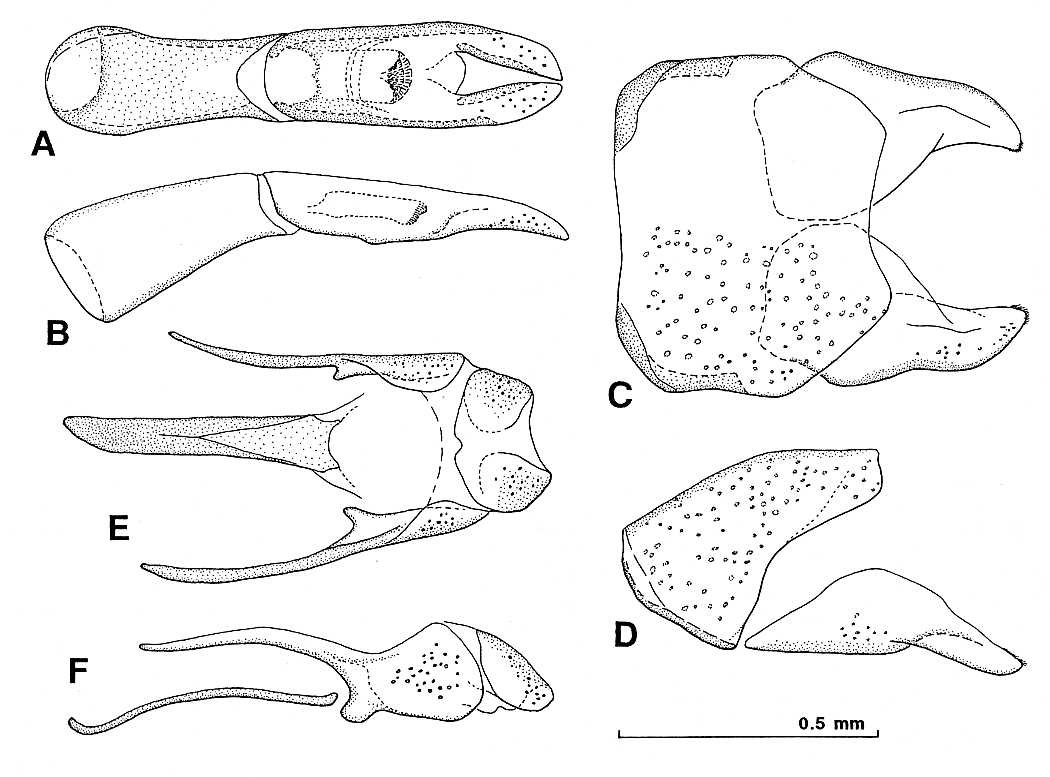Platysoma (Platylister) atratum Erichson,
1834
Japanese name: Indo-naga-emmamushi
Hister parallelipipedus Dejean, 1821: 48 (nom. nud.), homonymized
by Marseul, 1857: 472.
Platysoma parallelepipedum (sic): Dejean, 1837: 143.
Platysoma atratum Erichson, 1834: 110.
Platylister atratus: Lewis, 1905b: 13; Hisamatsu, 1986: 229;
Sawada, 1988: 40 [Miyake-jima, Izu Isles.].
Platysoma buteanum Desbordes, 1922: 7, synonymized by Cooman,
1948: 132.
Platysoma (Platylister) atratum: Ohara, 1994, 96.
Silinus atratus: Mazur, 1997, 62.
Original description. (Erichson, 1834).
"Oblongum, subdepressum, atrum, thorace laevi, elytris stria dorsali
prima nulla, secunda tertiaque valde abbreviatis. -- Long. 3 lin. -- Aus
Bengalen.
Verhaltnifsmafsig etwas schmaler als die vorigen Arten, flach gewolbt,
tief schwarz, mit mafsigem Glanze. Der Kopf ist dicht und fein punktulirt,
mit einem schwachen Langseindruck auf dem Scheitel; die Stirn ist vorn sanft
eingedruckt. Die Fuhler schwarz, mit etwas greis schillerndem Knopfe. Das
Halsschild ist nicht voll doppelt so breit als lang, nach vorn ein wenig
verschmalert, an den Seiten sehr sanft gerundet fein punktulirt; die Randlinie
ist an den Seiten sehr stark, vorn fein und ununterbrochen. Die Flugeldecken
sind fast etwas schmaler als das Halsschild, nach hinten unmerklich verengt,
sehr fein punktulirt; der erste Streif fehlt ganz, der zweite und dritte
nach vorn stark abgekurzt, die ubrigen ganz, stark; die Zwischenraume eben.
Das vorletzte obere Hinterleibssegment ist an dem Hinterrande auf jeder
Seite eingedruckt, mit einzelnen starken Punkten besetzt; das letzte Segment
ist stark punktirt, auf jeder Seite eingedruckt, am Rand kaum etwas erhaben.
Die Beine schwarz."
Ohara (1994)
Description. Body somewhat convex, oblong, black and shining; tibiae
dark brown; tarsi and antennae reddish brown. Body length, PPL, 4.69 - 6.25
mm (5.62 ± 0.11, n=14), PEL, 4.06 - 5.56 mm (4.99 ± 0.10,
n=14), Width, 2.69 - 3.56 mm (3.16 ± 0.07, n=14). Biometric data
are given in Table 10.
Surface of head (Fig. 57A) even but feebly depressed on apical half;
frontal stria usually interrupted at each apical angle behind eye, and well
impressed and carinate; disk evenly clothed with fine punctures which are
separated by about three times their diameter. Labrum transverse oblong,
its anterior margin strongly emarginate at middle. Mandibles stout, short,
and with longitudinal impression on dorsal surface.
Pronotal sides (Fig. 55A) parallel on basal third, convergent to apices
on apical two-thirds, but strongly convergent on apical sixth; emarginated
portion of anterior margin bisinuate with distinctly acute angle at middle
(Fig. 55A). Marginal pronotal stria complete and weakly impressed, its apical
end curved at apical angle and shortly extending inwardly. Pronotal lateral
stria somewhat deeply impressed and complete laterally, and narrowly interrupted
at middle on anterior portion; disk densely clothed with fine punctures
which are denser than those of the head.
Epipleural and elytral marginal stria weakly impressed and complete,
the apical end of the elytral stria extending along apical margin of elytra
and attaining until lateral half of elytron. Epipleura even and sparsely
clothed with fine punctures. Subhumeral stria absent. Oblique humeral stria
(Fig. 55A) present on basal third. First to 3rd elytral dorsal striae complete
and well impressed, the 3rd weakly bent inwardly on basal half. Fourth dorsal
stria short and present on apical sixth. Fifth often reduced basally, but
usually present on apical third. Disk of elytra evenly and densely covered
with fine punctures which are as dense as on the pronotum.
Propygidium (Fig. 57B) irregularly covered with large punctures, which
become finer along posterior margin and on a narrow longitudinal median
band; interspace among the large punctures evenly and densely covered with
fine punctures. Surface of propygidium even. Pygidium densely covered with
large punctures which are separated by one-third their diameter; interspace
among the large punctures sparsely clothed with fine punctures; narrow band
along posterior margin feebly elevated.
Anterior margin of prosternal lobe (Fig. 56A) round; marginal stria of
lobe deeply impressed, its lateral end strongly curved inwardly; disk flat,
densely covered with coarse punctures which are separated by their own diameter.
Prosternal keel narrow and without carinal stria; disk evenly covered with
coarse punctures; basal apex round. Lateral stria and lateral marginal stria
deeply impressed and carinate.
Anterior margin of mesosternum strongly emarginate at middle; marginal
stria well impressed and complete, rarely interrupted at middle of anterior
portion; disk densely and finely punctate. Meso-metasternal suture weakly
impressed. Punctation of intercoxal disk of metasternum slightly finer than
metasternal ones. Lateral metasternal stria deeply impressed, extending
obliquely and posteriorly, its apical end attaining near metacoxa. Lateral
disk densely covered with large and shallow punctures, which are usually
fused with each other on apical half.
Intercoxal disk of 1st abdominal sternum with a punctation similar to
that of intercoxal disk of metasternum; two lateral striae present on each
lateral side.
Protibia (Fig. 57C) with 4 denticles on outer margin. Mesotibia with
4 denticles, the median 2 denticles large. Metatibia with 4 denticles, the
basal one very small.
Male genitalia as shown in Fig. 58.

Remarks. Platysoma atratum resembles superficially P. horni; however,
the former can easily be distinguished by the different striation of the
elytra and the pronotal stria which is interrupted behind the head.
Little is known about the habitat of this species. It frequently occurs
in decaying pineapple and banana; it was sometimes collected also under
bark and in rotting wood, and, according to Sawada (1988), under decaying
Taro, Colocasia esculenta.
Table 10. Biometric data of Platysoma (Platylister) atratum Erichson
----------------------------------------------------------------------
APW 1.31-1.81 (1.52±0.03) 14
PPW 2.50-3.44 (3.05±0.06) 14
PL 1.50-2.19 (1.90±0.04) 14
EL 2.25-3.00 (2.74±0.05) 14
EW 2.69-3.56 (3.16±0.07) 14
ProW 1.69-2.25 (1.97±0.04) 14
ProL 0.44-0.69 (0.59±0.02) 14
PyL 0.63-0.94 (0.80±0.03) 14
PTL 0.94-1.25 (1.17±0.03) 14
MSTL 0.81-1.19 (1.03±0.03) 14
MTTL 1.00-1.31 (1.21±0.03) 14
----------------------------------------------------------------------
Distribution.
Japan (Kyushu, Izu Isles, Nansei Isles); India; Burma; Vietnam; Laos;
Taiwan; south-eastern China; Nepal.

Collectiong data. Ohara (1994)
[Nansei Isles.] <Tokara-Nakano-shima Is.> 1 ex., Nakano-shima,
22/vii/1986, H. Fujita leg.
Specimens examined [additional records]. (Ohara, 1999a).
[Nansei Isles] Tokara-nakano-shima: (1 ex., 14/v/1981), S. Morita. Amami-Oshima:
Nakagachi (3 exs., 8/iv/1991), T. Ueno.
Histeridae/Histerinae/Platysomatini/Platysoma/References


